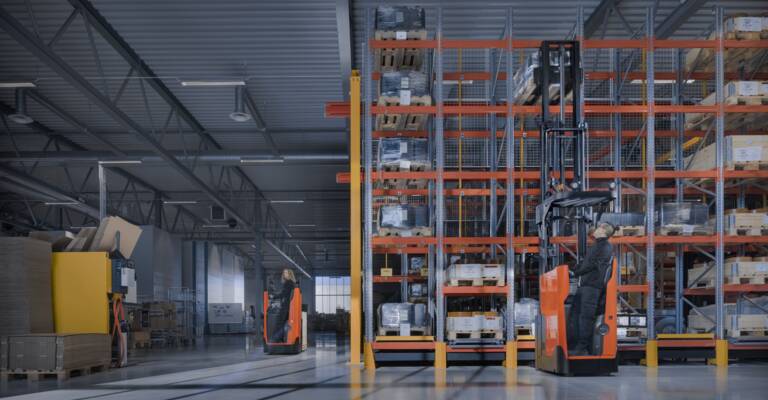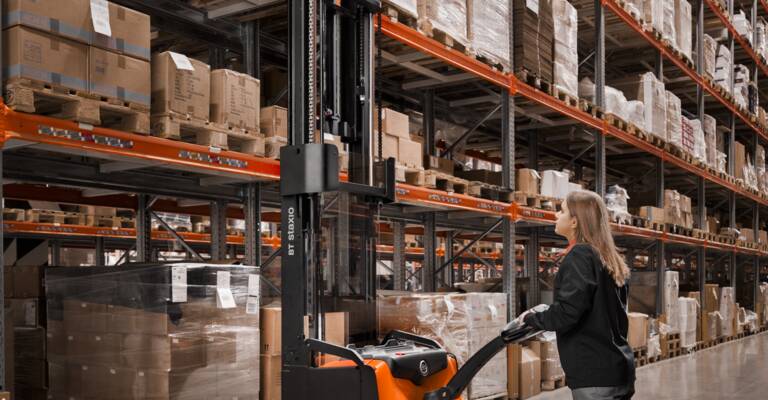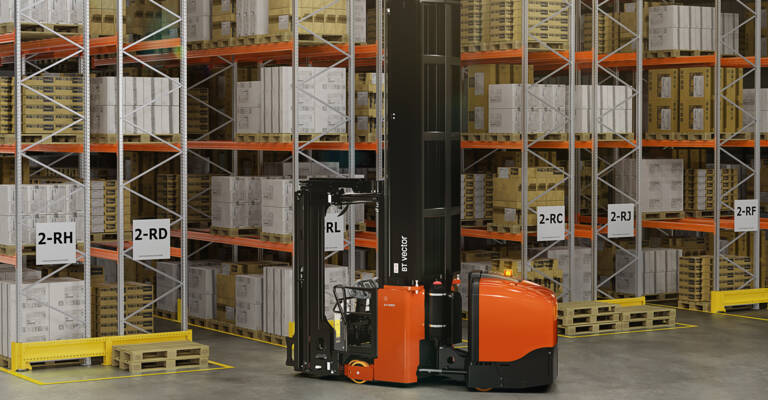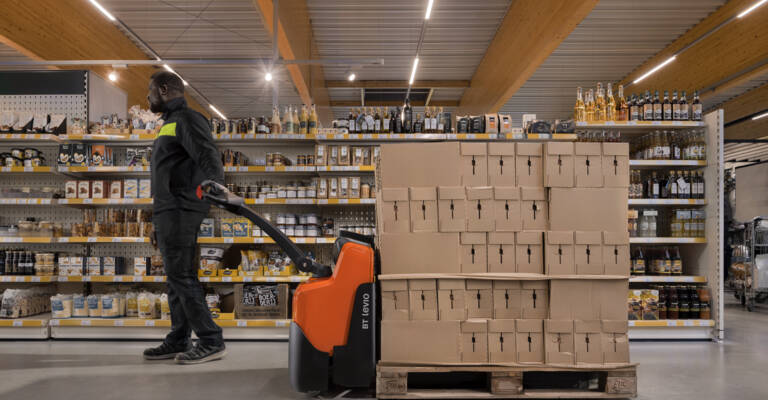Stackers
Powered stackers are compact and manoeuvrable and can lift pallets up to 6 metres high. Designed for light to heavy-duty stacking operations, our pallet stacker range offers great performance during horizontal transport, order picking, block stacking and stacking at elevated height. Whether it is used in the back of a store, on shop floors or in distribution centers or factories for long-distance transportation, you’ll find the right model in our range.
All powered pallet stackers
Find your next powered stacker

Let us guide you through 6 simple steps
We will help you find the best stacker truck for your business, with the help of the following steps:
- Driving
- Load handling
- Load carrier
- Manoeuvring
- Lifting
- Special requirements
Take the guide and find out which pallet stacker is your best match!
Pallet stackers as ergonomic workstation: how it works
FAQ & helpful insights
Here we have gathered frequent questions and answers about powered pallet stackers to help you find your next pallet stacker.
Operating powered pallet stackers
What are the benefits of pallet stackers?
Pallet stackers from Toyota Material Handling are compact and highly manoeuvrable, with load capacities ranging from 1 to 2 tonnes and lift heights up to 6 m. Very suitable for storage applications in warehouses, production areas or shops. The range includes pedestrian, platform and stand-in models.
What is the difference between a stacker for low-intensity work or high-intensity work?
Light-duty stackers such as the BT Tyro SHE and Toyota BT Staxio HWE are designed for occasional use: a few lifts and movements throughout the day. If you want a truck to perform frequently, it is recommended to go for a medium to heavy-duty machine.
Which pallet stacker is most suitable for work on ramps or thresholds?
To avoid damage to the powered stacker when driving up a ramp or over thresholds, a model with elevating support arms should be chosen. These models have a higher ground clearance to drive up on ramps.
When to choose for a stand-in stacker model?
There are different reasons to choose a platform stacker or stand-in stacker over a pedestrian one. If you would like to boost productivity, a platform machine will be faster. If you would like to improve ergonomics and safety for the driver, stand-in stackers can offer more protection and comfort.
How long does the battery last on pallet stackers?
This depends on the battery size. It is recommended to choose a battery capacity that lasts through the day when using lead-acid batteries, as charging takes 8 hours. For high-intensity, multi-shift operations, batteries need exchanging in between shifts. A more flexible option is lithium-ion technology. Available on the complete stacker range, it allows for charging in between breaks or when the truck is not in use. This permits an almost continuous operation of the stacker.
What is the difference between pallet stackers and reach trucks?
In essence, they can handle similar tasks, they both can transport pallets and store them at height. Main differences are:
- Compactness: pallet stackers have a more compact chassis and need less space to turn.
- Lift capability: Reach trucks lift much higher. Up to 13 m high, while stackers lift about 6 m.
- Speed: compared to a pedestrian version, productivity will be much higher with a reach truck. In general, the lift and drive speed is higher than on any stacker.
- Design: The operator is seated on a reach truck.
- Comfort and protection: a reach truck operator compartment is well laid out and offers great comfort and protection during the shift. However, stand-in stackers also have easy-to-reach controls and display for the operator’s comfort.
If you are looking for a forklift also for outdoor use, we recommend taking our electric forklift guide.
Load handling and pallet stacking
How do you measure loads?
Loads come in different sizes. Length and width help you define the right load carrier. The longer the load, the larger the load centre. Load dimensions may affect the lift capacity of your forklift and present limitations in terms of aisle width.
What is pallet overhang?
Pallet overhang occurs when goods are larger than the pallet. This can cause load damage. The right size of your load carrier or better goods placement on the pallet will improve material handling with a forklift.
What is the heaviest load a pallet stacker can lift?
Toyota’s stacker can lift loads up to 2000 kg. For higher load capacities we offer reach trucks or electric counterbalanced trucks.
What is the benefit of a pallet stacker with a retractable mast?
A stacker with retractable mast – same principle as on a reach truck – will be a good solution when the support arms of your stacker would be obstructed on ground level by, for example, a conveyor, racking or other obstacles. These forklifts also make side loading possible. Toyota offers retractable mast stackers with and without platform.
When is a dedicated double pallet stacker the right choice?
When you’re looking to improve your productivity, double stackers can be the right solution. They are designed to handle two loads at the same time, letting you move twice as much. Their compact chassis, low masts and double pallet handling also makes them useful to load or unload lorries.
Load carriers for pallet stackers
What loads can pallet stackers handle?
In most cases, stackers are used to handle EURO pallets from the short side. Some businesses have closed pallets, small pallets or non-standard load carriers to carry goods. Toyota has a wide range of stackers and options to suit these different carriers, e.g. different width over fork options, models with moving mast or straddle support arms.
Why do pallet stackers have different width over forks options?
To match the many different load carriers on the market and to optimise the stability of the load being handled. Typical width over forks: 570 mm for EU pallets.
What fork lengths can be chosen on stackers?
Typical fork length is 1150 mm, ideal to handle pallets 1200 mm long such as the EU pallet. Stackers can also be equipped with longer forks, up to 1400 mm, suitable to handle longer load carriers.
Can stackers be used for block stacking?
Block stacking is a way to store goods: the loads (pallet or other units) are placed on the floor and stacked on top of each other, building stacks up to a stable safe height. Pallet stackers are ideal for pallet block stacking. They are narrower than the short side of a EURO pallet and thus optimise space utilisation to the max.
Aisle width and pallet stacker manoeuvring
What does aisle width mean?
The aisle width is the minimum space a forklift needs to turn in an aisle (or in between racking, or other, to place or retrieve a load).
How do you calculate the aisle width you need?
Calculation differs depending on the model. The specifications that need to be considered to calculate the aisle width (Ast) are:
- Turning radius (Wa): the minimum radius a forklift needs to turn around fully.
- Load dimensions: the width (b12) and length (l6) of the load define the space needed for the truck to place the load.
- Load distance (x): the horizontal distance from the centre of the front wheels to the front of the forks.
- Safety clearance (a): 200 mm for safer navigating in aisles.
Where to find the aisle width of your current truck fleet?
Aisle width data is mentioned in the data sheet of each forklift; Comparing data sheets of various models allows you to find the best match for your operation.
What difference in turning radius is there between stacker and reach truck?
A pedestrian stacker is very compact and has a typical aisle width of 2200 mm (carrying a EU pallet without overhang). If you go for a platform or stand-in version, the required width increases to around 2500 mm. A reach truck needs a minimum aisle width of about 2800 mm.
How to define the right forklift for a given aisle width?
If you want to buy a new truck, you need to make sure the truck is suitable for the space. Here are four things you should have in mind to find the right forklift for the aisle width you have:
- Measure the distance between the racking to make sure the forklift can turn in this area. Pay attention to racking protection, pallet overhang, pedestrian pathways, etc.
- The aisle width for forklifts with standard load dimensions can be found in the datasheet. For non-standard loads, the aisle width needs to be calculated.
- If you use different types of trucks, check the aisle width requirements for all.
- When changing truck model, double-check the measurements, there might be differences in turning radius.
Lifting pallets with a powered stacker
How do you define maximum forklift lift height?
To know the maximum lift height, find out the height of the highest racking beam and add 150-200 mm to give the operator some extra manoeuvring space to put away the load.
How high do pallet stackers lift?
The light-duty models, double stackers and mono mast machines like Toyota BT Staxio HWE100 and SWE080L are designed for low-lift applications and can be used as an ergonomic worktable. These masts go up to 2 m. All other stackers have a range of masts with lift heights up to 6 m.
Why are door and gate heights important when buying a stacker?
Either the forklift roof height or collapsed mast height will define which is the lowest height it can go under. Mind, when the forks are raised with a non-freelift mast, the inner mast section will lift as soon forks go up, influencing the lowest passing point. Also pay attention to the support arm lift height as it will also influence the total height.
What is the residual capacity of a forklift?
A forklift truck’s load capacity or nominal capacity is calculated as the maximum weight it can raise to a pre-determined height, when its load centre is at a certain point. If the load needs to be lifted above that height, or the load centre is further away, then the capacity will be lowered. That’s what residual capacity is: the actual lifting ability in a given situation, which may be less than the nominal capacity.
What mast types are available on pallet stackers?
Depending on application and lift height needed, the pallet stacker range from Toyota comes with these mast types:
- Single-stage mast: This one-section mast relies on a single frame and has limited lift height.
- Single-stage mono mast: This is a centrally positioned mast. Suitable for low lift heights where the operator often works close to the truck, e.g. when using it as a worktable.
- Two-stage mast with limited free lift: This mast, with two sections has two cylinders positioned along the sides. Clear view on the forks.
- Two-stage mast with central lift cylinder: A two-section mast with maximum free lift range. This mast combines high lift heights with a low mast height.
- Three-stage mast with central lift cylinder: A three-section mast with central lift cylinder and maximum free lift for very high lift heights in combination with a low mast height.
Applications with special requirements
Can stackers be used outside?
No, pallet stackers are not designed for outdoor use. Suitable forklifts for indoor and outdoor use are Toyota electric counterbalanced trucks, engine-powered trucks or outdoor reach trucks.
Can powered stackers be used as worktable?
Pallet stackers can indeed be used to work more ergonomically when picking goods from pallets. Forks can be placed at picking height. Even better, the Toyota BT Staxio HWE100 and SWE080L models come with automatic height adjustment option, where a photocell detects when something is placed on the pallet or taken off and adjusts the height automatically to the best picking height. Ideal for replenishing in shops or to serve as small workstations in a production line where goods are packaged and prepared before being transported.
Where do you find information of the gradeability of a stacker?
When selecting a forklift truck, you should verify if the model is capable of operating on the gradients you have on your site. The gradeability rating can be found in the truck’s data sheet. The maximum gradeability is the maximum grade a forklift can climb over a short period. Not only the ability to climb a slope is important, but also safely descending it when loaded. The ground clearance of the forklift must also be taken into account.
Can a pallet stacker be used for loading /unloading lorries?
Stackers with elevated support arms can be used to load or unload lorries from the back of a lorry, via a loading bay or tailgate. Double stackers are highly efficient and well suited for this application. The retractable mast stacker family can load a lorry from the side.
Are pallet stackers suitable for cold store?
Toyota stackers are designed to work effectively without the need for modification in temperatures dipping to 0°C. However, for temperatures as low as -30°C, it is recommended to add protection to the trucks. Specific features can include cold store oil, anti-slip platforms and heated batteries.
For cold store related questions, get in touch with our sales experts.




